|
 ANCIENT WELL LOGS
ANCIENT WELL LOGS
The
oil, gas, and mineral industries have had an impact on every human on
Earth. The evolution
of log analysis methods over the years is less dramatic, but equally
fascinating and illuminating.
Due
to its age and scientific diversity, arcane and traditional definitions, abbreviations, symbols, and methods
still pervade our industry. Newcomers often wonder why these old-fashioned
ideas persist. In many cases, methods were developed which required
better logging tools or more powerful computational methods than
were available at the time. Such methods fell into disuse, to
be resurrected years later when the appropriate tools were developed.
An appreciation of the history of logging and the development
sequence of analytical methods will help any geologist, geophysicist,
or engineer who
works with well logs.
.jpg) The
first logs were probably made on scraps of paper and note books
by a surveyor, William Smith, in England between 1798
and1820, but they were made in coal mine shafts, canal banks,
and any other place with exposed rocks. He recognized
layered strata by the obvious changes in rock type, colour, and
texture, and developed correlation of layers across long
distances by fossil identification, thus becoming the first
paleontologist. From these he created and published the first
geological maps, cross-sections, and perspective drawings. At
age 62, in 1831 the Geological Society of London conferred on
Smith the first Wollaston Medal in recognition of his
achievements. Dublin gave him a Doctor of Laws - not bad for a
man with little formal education, who learned everything "on
the job". The
first logs were probably made on scraps of paper and note books
by a surveyor, William Smith, in England between 1798
and1820, but they were made in coal mine shafts, canal banks,
and any other place with exposed rocks. He recognized
layered strata by the obvious changes in rock type, colour, and
texture, and developed correlation of layers across long
distances by fossil identification, thus becoming the first
paleontologist. From these he created and published the first
geological maps, cross-sections, and perspective drawings. At
age 62, in 1831 the Geological Society of London conferred on
Smith the first Wollaston Medal in recognition of his
achievements. Dublin gave him a Doctor of Laws - not bad for a
man with little formal education, who learned everything "on
the job".
 Well logging began around 1846
when William Thomson (Lord Kelvin) made measurements of
temperature in water wells in England. His first technical paper
on the subject was "Age of the Earth and its Limitations as
Determined by the Distribution and Measurement of Heat within
It". Kelvin's calculated age was 20 - 40 million years.
Since radioactivity had not
been discovered yet, Kelvin was unaware of the heat generated
internally from this source, so he can be excused for a
100-fold error in his estimate of the Earth's age. Controversy,
debate, and a slew of additional papers ensued for another 50
years. Well logging began around 1846
when William Thomson (Lord Kelvin) made measurements of
temperature in water wells in England. His first technical paper
on the subject was "Age of the Earth and its Limitations as
Determined by the Distribution and Measurement of Heat within
It". Kelvin's calculated age was 20 - 40 million years.
Since radioactivity had not
been discovered yet, Kelvin was unaware of the heat generated
internally from this source, so he can be excused for a
100-fold error in his estimate of the Earth's age. Controversy,
debate, and a slew of additional papers ensued for another 50
years.
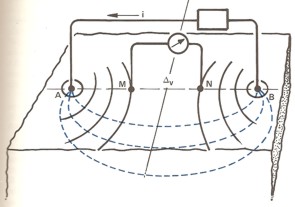 Conrad
and Marcel Schlumberger began to experiment with surface resistivity
measurements in 1912 and by 1919 were offering a commercial service.
Schlumberger ran such surveys until 1928, when the service was
merged into Compangnie General de Geophysique, a geophysical company
partly owned by Schlumberger. Conrad
and Marcel Schlumberger began to experiment with surface resistivity
measurements in 1912 and by 1919 were offering a commercial service.
Schlumberger ran such surveys until 1928, when the service was
merged into Compangnie General de Geophysique, a geophysical company
partly owned by Schlumberger.
Four electrode surface
resistivity system 
The surface resistivity method was based on a four electrode system,
moved along the surface to make successive measurements. Direct
current was applied to the outer two electrodes (A and B) and the
voltage between the inner electrodes (M and N) was measured.
Variations in the voltage indicated changes in subsurface
resistivity, which in turn indicated changes in mineralogy or fluid
content in the subsurface. Surveys were run for mining, ground
water, and oil exploration.
Although direct current was widely
used, the Schlumberger brothers also experiment with alternating
current systems, the forerunner of modern electromagnetic (EM)
surface exploration methods.
They also had a brain-wave in 1927
- why not run the four electrode system vertically in a borehole
instead of horizontally on the surface? The general idea was not
new.
A
patent for a single electrode resistivity device was issued in
1883 to Fred Brown, but it appears not to have seen use until
1913 in a mining drill hole. A single electrode survey is not
very useful quantitatively but the four electrode system can be
calibrated to read resistivity of the material surrounding the
electrodes.
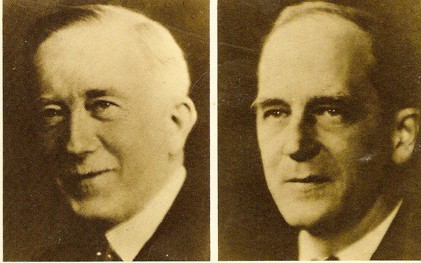 The
brothers convinced the Pechlebronn Oil Company, drilling
in Alsace, France, to try such electrical measurements as an aid
to understanding the rock layers. The first such log in the USA
was run on 17 August l929 for Shell Oil Company in Kern County,
California. Logs were run that same year in Venezuela, Russia,
and India. The
brothers convinced the Pechlebronn Oil Company, drilling
in Alsace, France, to try such electrical measurements as an aid
to understanding the rock layers. The first such log in the USA
was run on 17 August l929 for Shell Oil Company in Kern County,
California. Logs were run that same year in Venezuela, Russia,
and India.
Conrad and Marcel Schlumberger 1936 
The
first well logs in Canada were run in 1937 (Schlumberger) for a gold exploration
project in Ontario, and in 1939 (Haliburton) for oil in Alberta.
The first Schlumberger log for oil exploration in Canada was run in
1946.
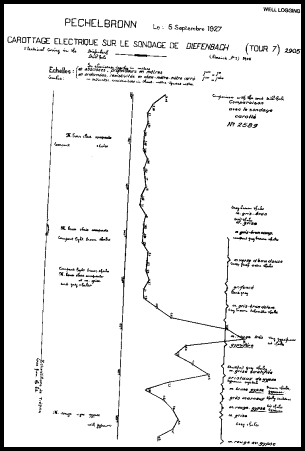
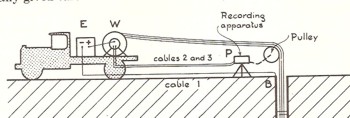
A portion of the first
resistivity log from Pecellebron 1927 (left) and the surface
equipment circa 1930 (right). Various re-drafted versions of the
first log have been published - this one looks pretty authentic.
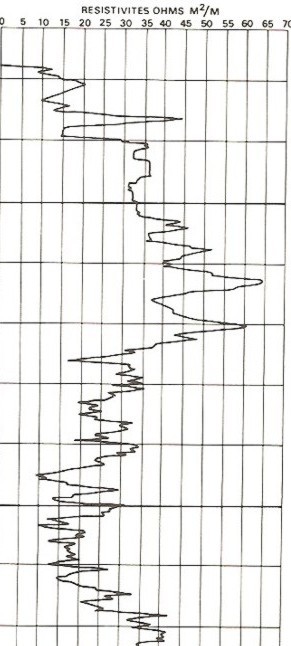 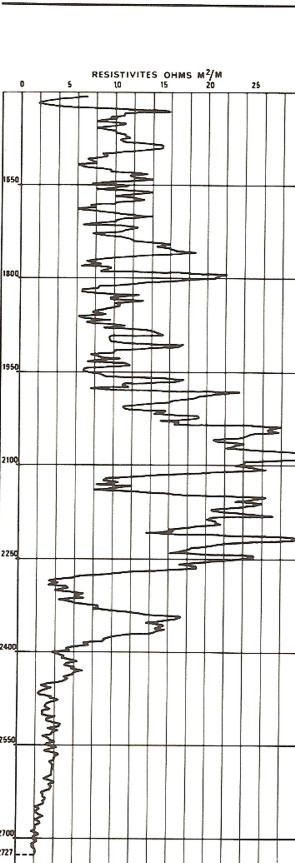 
First logs outside France 1929:
Maracaibo, Venezuela (left); Los Angeles, California (center);
Oklahoma City, Oklahoma (right). Note that some logs were presented
on linear scales and some on logarithmic scales; the latter did not
reappear until the early 1960's. There was no SP curve as it had not
yet been invented.
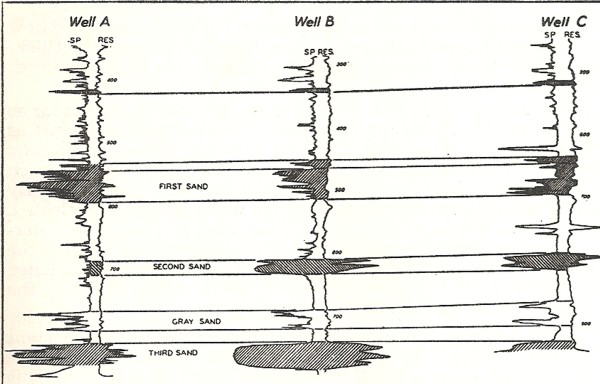
Logs from 1932 in Oil City-Titusville area, Pennsylvania, the
location of Edwin Drake's "First Oil Well". His well was only 69
feet deep, so it penetrated just to the top of these logs, which
found deeper and more prolific reservoirs.
His well was the first in the USA, but 5 other countries produced oil from
wells prior to his discovery. The SP, introduced in 1931, helps
locate good quality sands in this relatively low resistivity
interval.
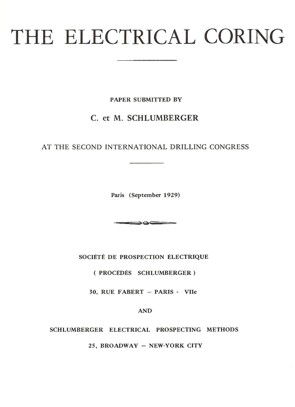 The first recognizable technical paper on log
analysis, entitled "Electrical Coring"
by the Schlumberger brothers, was published in 1929. A second,
including E. G. Leonardon as co-author, described the ES and SP logs,
and was published in 1934. The first recognizable technical paper on log
analysis, entitled "Electrical Coring"
by the Schlumberger brothers, was published in 1929. A second,
including E. G. Leonardon as co-author, described the ES and SP logs,
and was published in 1934.
First Log
Analysis Technical Paper, 1929 
Log analysis
using these new tools involved curve-shape recognition - still
a valid and commonly used qualitative approach to analysis.
Log curve shapes are determined visually from the appearance of
the recorded data when plotted versus depth. These curve shapes
were related to rock sample and core description data to determine
general rules-of-thumb for separating permeable, porous, oil bearing
beds from non-productive zones.
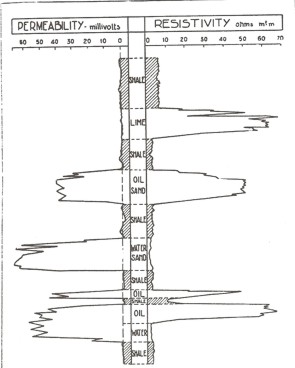
 Curve shape analysis rules:
Curve shape analysis rules:
1. low SP, low resistivity = shale
2. low SP, high resistivity = tight carbonates or fresh water sand
3. high SP, high resistivity = oil or gas reservoir
4. high SP, low resistivity = salt water reservoir
The
early success of curve shape analysis was quite accidental.
It depended on the fact that the formation water in the first
wells logged was quite conductive due to dissolved salt. Had these
logs been run in west Texas at the beginning of the 1930's,
the fresh water sands may have given such confused analyses
that well logging might never have become popular.
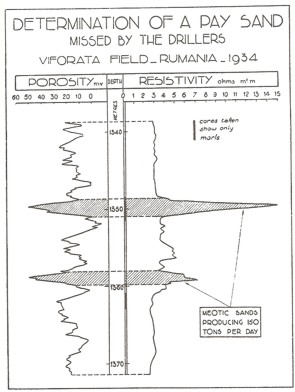
Curve shape analysis in Rumania,
1934. Note that the SP in the left hand track is variously labeled
Porosity or Permeability (on previous illustration). The SP is only
slightly related to these rock properties, so these terms were
dropped after a suitably short "marketing" campaign.

Some attempts
were made to quantify the resistivity and SP analyses during the
1930's, but they applied only to local situations. It was not until
1942 that G. E. Archie's work provided a reasonably universal
approach.
The original
resistivity log electrode arrangement provided what is known today
as a "lateral" curve. It is an asymmetrical curve and is not
appropriate in thin reservoirs. During the 1930's there was
considerable experimentation with electrode spacings and electrode
arrangements. An alternate to the lateral curve was the so-called
"normal" curve. It provided symmetrical curve shapes but could not
read as deep into the rock as the lateral curve.
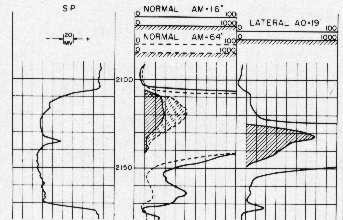 The
log presentation and the recording equipment evolved quickly during
this period and the relatively standard 3-track log presentation we
see today was common by 1945. The
log presentation and the recording equipment evolved quickly during
this period and the relatively standard 3-track log presentation we
see today was common by 1945.
 Semi-standard 3-track log presentation circa 1940's with SP in Track
1, deep and shallow normal resistivity curves in track 2, and
lateral curve in Track 3.
Semi-standard 3-track log presentation circa 1940's with SP in Track
1, deep and shallow normal resistivity curves in track 2, and
lateral curve in Track 3.
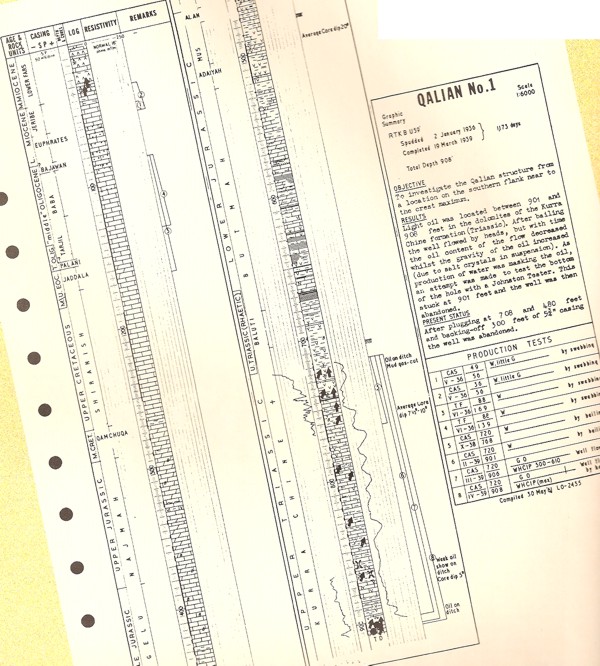
First log in Iraq, 1938
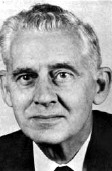 Thirteen
years after the original Schlumberger paper in 1929, G. E. Archie
developed the empirical data behind the concept of "formation
factor" and "resistivity index" - terms used to relate the porosity, the resistivity
log reading, and the water saturation in a reservoir. This 1942
paper revolutionized
log analysis, as the subject was now quantitative rather than
only qualitative. In practice, however, the errors due to borehole
effects on the measurements and uncertainty about other items
relating formation factor to porosity, prevented really accurate
results. Thirteen
years after the original Schlumberger paper in 1929, G. E. Archie
developed the empirical data behind the concept of "formation
factor" and "resistivity index" - terms used to relate the porosity, the resistivity
log reading, and the water saturation in a reservoir. This 1942
paper revolutionized
log analysis, as the subject was now quantitative rather than
only qualitative. In practice, however, the errors due to borehole
effects on the measurements and uncertainty about other items
relating formation factor to porosity, prevented really accurate
results.
W.
O. Winsauer, with others, modified the Archie equation slightly
in 1952. This formula is used today but is commonly known as the
Archie equation. M. P. Tixier of Schlumberger published the details
of the so-called Rocky Mountain or resistivity ratio method in
1949. It was based on Archie's water saturation equation, but
avoided the need to know porosity by using the ratio of deep and
shallow resistivity readings.
Studies
of invasion profiles and water chemistry reactions were thus common
during this period.
From
its earliest beginnings, the spontaneous potential log was interpreted
by its curve shape. Since an SP voltage was developed across sandstones,
and not along shale beds, it was relatively easy to identify sandstone
from shale by the shape of the SP curve. Between 1943 and 1949,
much work was done on the theory behind the spontaneous potential.
Analysis from this curve is still popular because it gives
approximate values for formation water resistivity in clean (non-shaly)
sandstone formations, or the shaliness of the formation in shaly
sandstones.
Shale
content calculations were enhanced by the appearance of the gamma
ray log in 1934 because shale emitted natural gamma rays and clean
sandstone and limestone did not. The log was calibrated to present
a curve similar in shape to the spontaneous potential log. Although
the gamma ray log has existed for seventy years, its appearance
has not changed much. However, its resolution and accuracy have
improved greatly due to more efficient and smaller gamma ray detectors.
 The
structural dip of rock formations is an important piece of knowledge
for geologists. The first dipmeter log using three simultaneous
spontaneous potential measurements spaced equally around the perimeter
of the borehole, was run in 1942. It was superceded in 1947 by
three simultaneous resistivity measurements. The theory of
analysis
was simple. Slight offsets in the depth of the bed boundaries
recorded by each of the three curves, plus the tool geometry,
hole diameter, and tool orientation in space, could be reduced
to give the dip of the bed boundary. Initially this was done by
hand comparison, later in manually operated optical comparators
and now by computer cross-correlation. The work was tedious and
fraught with difficult decisions when the curves wiggled too much
or not enough. The
structural dip of rock formations is an important piece of knowledge
for geologists. The first dipmeter log using three simultaneous
spontaneous potential measurements spaced equally around the perimeter
of the borehole, was run in 1942. It was superceded in 1947 by
three simultaneous resistivity measurements. The theory of
analysis
was simple. Slight offsets in the depth of the bed boundaries
recorded by each of the three curves, plus the tool geometry,
hole diameter, and tool orientation in space, could be reduced
to give the dip of the bed boundary. Initially this was done by
hand comparison, later in manually operated optical comparators
and now by computer cross-correlation. The work was tedious and
fraught with difficult decisions when the curves wiggled too much
or not enough.
The
modern dipmeter tool, first used in 1969, records four or more
simultaneous resistivity curves, which provides considerable redundancy,
and hence improved quality in the results. Data is often so good
as to allow analysis of stratigraphic features, such as
crossbedding in sandstone deposits, as well as the much larger
structural features of the rock layers detected by earlier tools.
The
section gauge (or caliper log) also appeared in 1942 and made
the application of borehole size corrections to all kinds of resistivity
logs possible. The use of laboratory derived departure curves
for this purpose, (between 1949 and 1955), was a common event
in a log analyst's life. The corrections were seldom satisfying
and may have been "gilding the lily" somewhat. Modern
resistivity logs need little borehole correction if run in a well
designed mud system in a reasonably good hole.
 Additional
logging tools have existed for a long time, and are used as aids
to analysis of other logs. One is the formation tester,
which measures the formation pressure and obtains a fluid sample,
usually of the invaded zone. It was first run in l957. Refinements
with digital recording techniques proved very helpful in sorting
out reservoir fluid content and reservoir continuity. The log
made by the formation tester is of pressure versus time instead
of a depth dependent log. Many such tests taken at different depths
can provide a formation pressure versus depth log for analysis
of pressure gradients. Additional
logging tools have existed for a long time, and are used as aids
to analysis of other logs. One is the formation tester,
which measures the formation pressure and obtains a fluid sample,
usually of the invaded zone. It was first run in l957. Refinements
with digital recording techniques proved very helpful in sorting
out reservoir fluid content and reservoir continuity. The log
made by the formation tester is of pressure versus time instead
of a depth dependent log. Many such tests taken at different depths
can provide a formation pressure versus depth log for analysis
of pressure gradients.
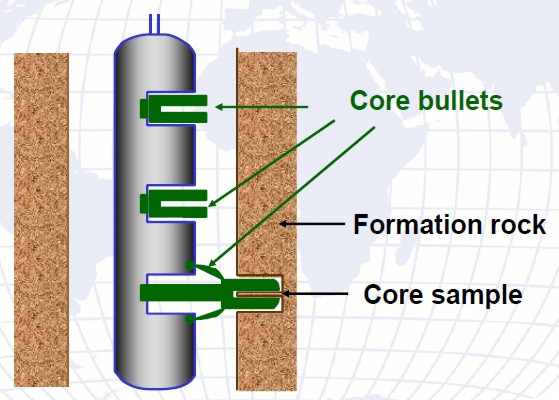 The
sidewall core gun (sample taker) was first used in l942. It used
a large hollow bullet, tied to the tool by wires, to retrieve
a small plug of rock from the well bore. Anywhere from a few to
forty eight bullets could be shot sequentially in one trip into
the well. Other than an SP or GR correlation log taken for depth
control, no real log is recorded by the sample taker. Other types
of core retriever have been used with limited success. The
sidewall core gun (sample taker) was first used in l942. It used
a large hollow bullet, tied to the tool by wires, to retrieve
a small plug of rock from the well bore. Anywhere from a few to
forty eight bullets could be shot sequentially in one trip into
the well. Other than an SP or GR correlation log taken for depth
control, no real log is recorded by the sample taker. Other types
of core retriever have been used with limited success.
The
temperature log, used to detect entry of gas into the well bore,
was made available about l936. It was also used to determine formation
temperature and temperature gradient.
Much
evolution was going on behind the scenes that the log analyst
never really appreciated, but the logging engineer did. The rag-line
logging cable gave way in l947 to steel armoured multiconductor
cable, which was far stronger and more reliable. Today, fiber
optic cables are sometimes used. The tools evolved from purely
electrical devices with ammeters and voltmeters, to vacuum tubes
in the late forties, to transistors in the early sixties and finally
integrated circuits and computers in the seventies and eighties.
Trucks
changed radically from short wheel base, opencab flat decks with
equipment bolted to the floor and shaded from the elements by
an umbrella, to canvas covered vans in the early forties. Bread
wagon style panel vans appeared in the late forties, to be superceded
by the six and ten wheel "corn binders" of the fifties
and sixties. The air conditioned behemoths of today, that look
ever so much like space age garbage trucks, are the result of
the computer revolution.
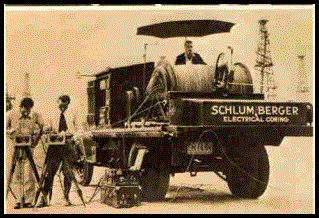
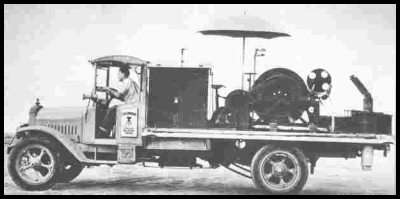
1932
1934
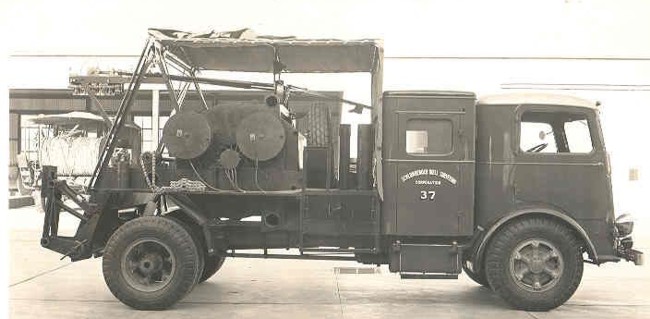
Schlumberger truck 1937 Mack EB
Service
availability, both in the number of trucks and the number of locations
where they were available, increased dramatically. The far flung
network was held together by the professionalism and integrity
of the early pioneers. Today it is big business - multi-national
and vertically integrated.
Trucks
were moved offshore by barge and boat in the forties, and finally
in 1947 when you couldn't see land from the rig anymore, genuine
offshore skid units were built and placed on the rigs. Wave compensation
devices and corrosion engineering solved many initial problems
by the late fifties.
In
sum, the early years were a period of invention and ingenuity
- solving problems as they arose, and surviving the Great Depression
and World War II by sheer determination.
 DEVELOPMENTS
IN WELL LOGGING
DEVELOPMENTS
IN WELL LOGGING |
| |
1798 First
stratigraphic logs William Smith
1846
First temperature log Lord Kelvin
1883 Single electrode resistivity log patented
Fred Brown
1912 First surface resistivity survey Conrad
Schlumberger
1927 First multi-electrode electrical survey in a
wellbore (in France)
1929 First electrical survey in California (also Venezuela,
Russia, India)
1931 First SP log, first sidewall core gun
1932 First deviation survey, first bullet perforator
1933 First commercial temperature log
1936 First SP dipmeter
1937 First electrical log in Canada (for gold in Ontario)
1938 First gamma ray log, first neutron log
1939 First electrical log in Alberta
1941 Archie's Laws published, first caliper log
1945 First commercial neutron log
1947 First resistivity dipmeter, first induction log
described
1948 First microlog, first shaped charge perforator
1948 Rw from SP published
1949 First laterolog
1952 First microlaterolog
1954 Added caliper to microlog
1956 First commercial induction log, nuclear magnetic
log described
1957 First sonic log, first density log
1960 First sidewall neutron log (scaled in porosity
units)
1960 First thermal decay time log
1961 First digitized dipmeter log
1962 First compensated density log (scaled in density/porosity
units)
1962 First computer aided log analysis, first logarithmic
resistivity scale
1963 First transmission of log images by telecopier
(predecessor to FAX)
1964 First measurement while drilling logs described
1965 First commercial digital recording of log data
1966 First compensated neutron log
1969 First experimental PE curve on density log
1971 First extraterrestrial temperature log Apollo
15
1976 First desktop computer aided log analysis system
LOG/MATE
1977 First computerized logging truck
1982 First use of email to transmit data via ARPaNet
(predecessor to Internet)
1983 First transmission of log data by satellite from
wellsite to computer center
1985 First resistivity microscanner |
|
|

